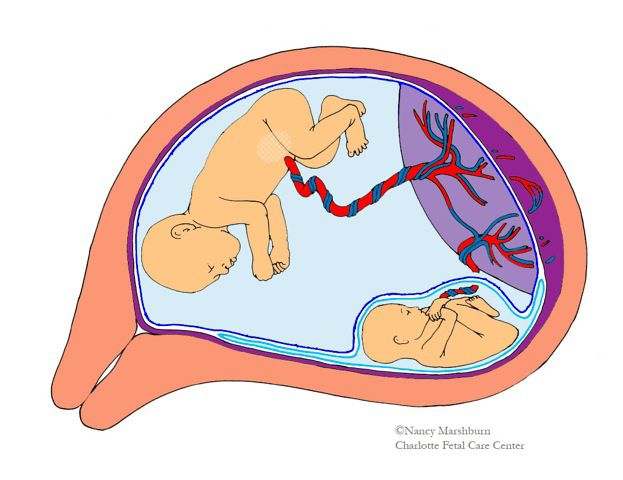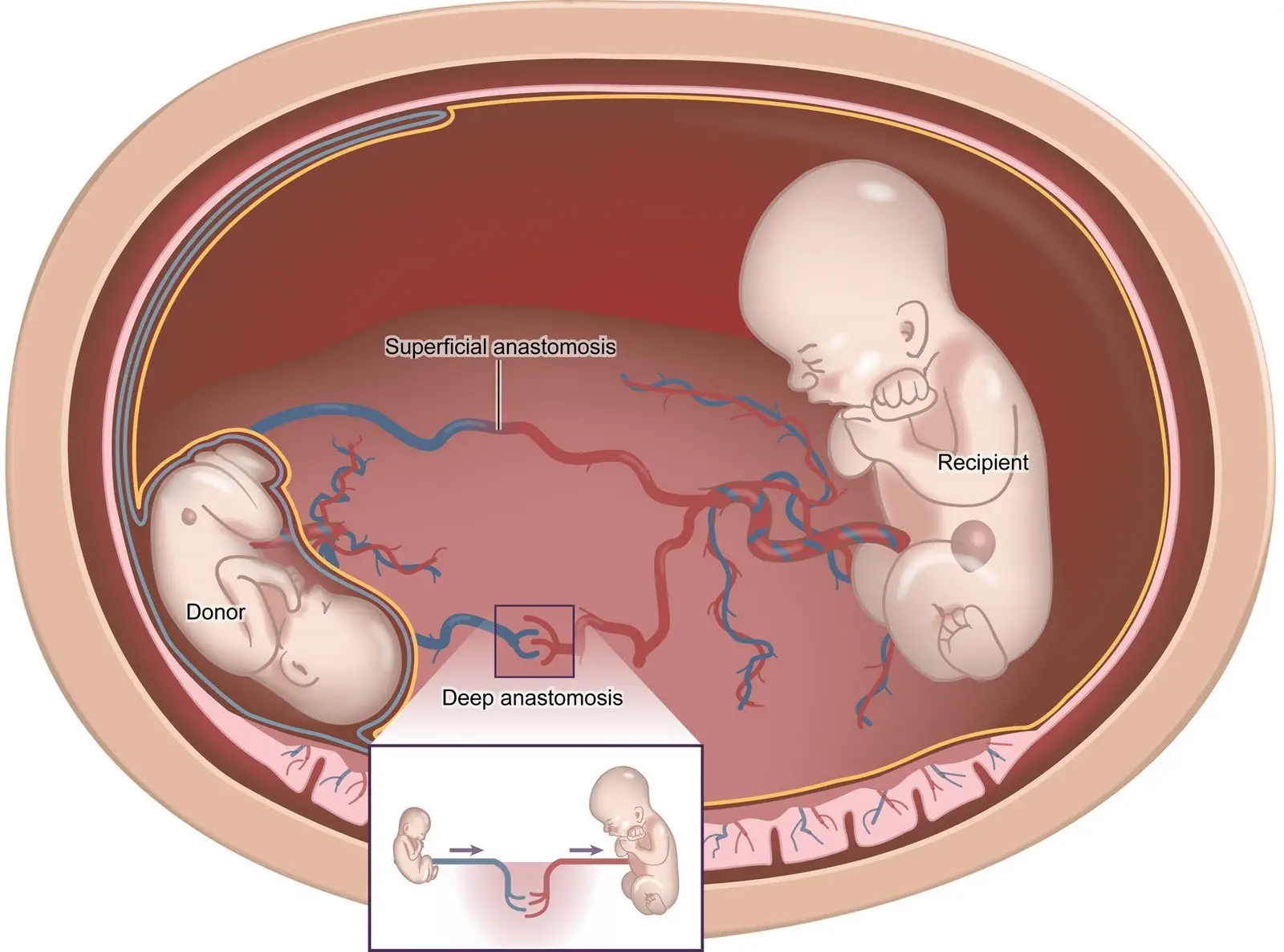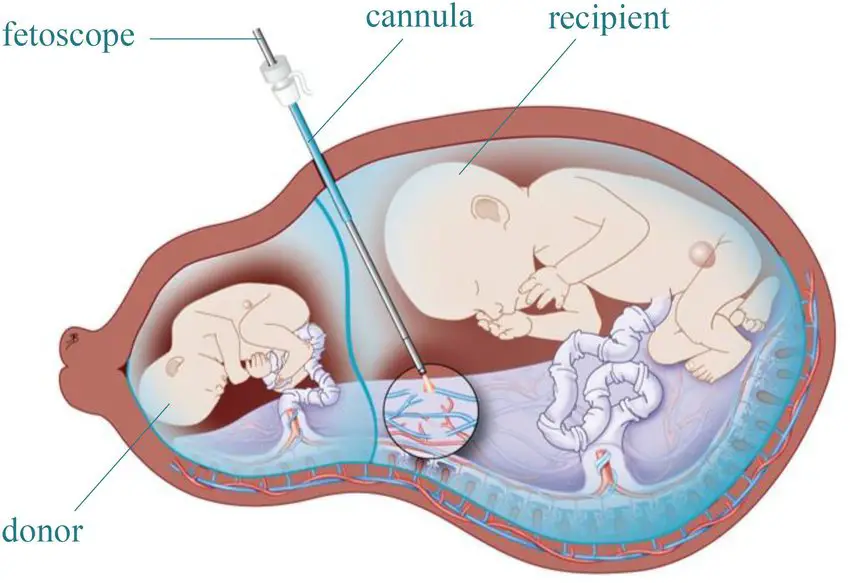Recognizing Symptoms: The Maternal Mirror Syndrome
TTTS is usually identified through ultrasounds and prenatal testing before you feel anything more than typical symptoms of pregnancy. When TTTS has progressed, you may experience maternal mirror syndrome. This is when your symptoms mimic those of the recipient baby, who has increased cardiovascular activity.
You may experience the following:
- severe swelling
- vomiting
- high blood pressure
Maternal mirror syndrome is rare but serious. Seek medical care if your pregnancy is affected by TTTS and you have any of these symptoms. You may be admitted to the hospital to control your symptoms and to monitor your twins.
Laser Surgery Placental Ablation
Placental ablation is the only treatment that targets the cause of the TTTS and is generally performed between 16-24 weeks. Surgeons insert a thin telescope into the uterus and use a laser to block the blood vessels connected between the two foetuses. This allows each twin to develop independently.While the maternal risk of fetal surgery is minimal, both minor and major complications can occur.
What Are The Symptoms Of Twin To Twin Transfusion Syndrome
Although often unrecognizable, there are signs that may alert the mother of abnormality. For instance, have you experienced unusually quick belly growth , or is your uterus measuring larger than usual? Additionally, if you are experiencing pain, tightness or contractions , or early-onset edema , this could be signs.
Also Check: Is Halo Top Safe During Pregnancy
What Is The Outcome For A Fetus With Ttts
In Twin-to-Twin Transfusion Syndrome , the donor twin responds to anemia and low volume by trying to make the most efficient use of the blood it does have. Blood is shunted preferentially to the most vital organs , and away from other, less vital, internal organs such as the kidneys. This partial shutdown of the kidneys results in the fetus making less urine. Because amniotic fluid is mostly comprised of fetal urine, the reduced urine output results in low amniotic fluid level, or oligohydramnios.
As the kidneys make less and less urine and the degree of oligohydramnios worsens, the fetal bladder may become empty and no longer visible by ultrasound . Meanwhile, the recipient becomes overloaded with fluid as a result of the on-going blood transfusion from the donor twin, and responds by producing large amounts of urine in an effort to reduce all of its excess volume. This leads to very large amounts of amniotic fluid in the recipients sac . It is the combination of oligohydramnios and polyhydramnios in a MC twin pair seen by ultrasound that indicates the diagnosis of TTTS. Careful obstetric ultrasound is crucial for correctly detecting and diagnosing TTTS during pregnancy. The ultrasound exams at our center are performed by specialists, widely renowned for their diagnostic skills and expertise in this field, who have written textbooks and many scientific articles about fetal conditions, such as TTTS and unequal placental sharing.
And Now For Another Study

The second study on the topic of protein in MoDi twin pregnancy was published in 2008 by Dr. Giuseppe Chiossi. He had extensively reviewed Dr. DeLias study and set out to see if the nutritional status of the mother had any impact on whether or not they developed TTTS during their pregnancy. The idea was to take Dr. DeLias findings further and see if protein was an effective way to help prevent TTTS from happening.
This study was a comparative study, meaning the researchers took two groups and compared their outcomes. The control group was made up of 51 previous MoDi pregnancies between 1997 and 2001. The researchers were able to get data regarding any diagnoses that occurred during these pregnancies.
The experimental group was made up of 52 women pregnant with MoDi pregnancies and the data was collected between 2001 and 2005. This group was given a particular brand of protein drink with 9 grams of protein, 3 times a day. All the pregnancies were followed in a center from referral through delivery.
In both the control and experimental groups, a TTTS diagnosis was made based on Quintero staging.
In the control group, some blood testing hadnt been routinely performed, but there was enough data to compare to the experimental group.
These two groups did not vary much when it came to age, weight gain, or for how long they carried.
Read Also: When Can I Find Out If I Am Pregnant
Ttts And Taps Treatment: Why Choose Johns Hopkins
- The Johns Hopkins Center for Fetal Therapy understands the urgency of a diagnosis of TTTS and TAPS. We are available to take your call at any time and will see you as soon as possible.
- Using the latest imaging technology, we are able to assess the severity of the condition and diagnose potential pregnancy complications before they arise. We will then work together to determine the best treatment plan for both you and your family.
- For over a decade, our fetal surgeons have performed extensive fetoscopic laser surgeries for the treatment of TTTS and TAPS. We were one of the first to establish the benefits of the Solomon laser technique, which offers the best chance of resolving TTTS and TAPS in a single treatment procedure and can be performed in some of the most complicated cases.
- We also have expertise managing a range of pregnancy complications related to TTTS and TAPS, including pre-term labor or cervical shortening. We closely monitor your pregnancy to ensure the best outcome for both you and your babies.
.
Ways To Treat Ttts After Birth
If left untreated, the twin-to-twin syndrome survival rate is very poor approximately 1015 percent. Even if both babies are delivered, the mortality rate of severe TTTS is 60100 percent, and theres also a very high risk of neurologic injuries.
The treatment for TTTS twins after delivery will largely depend on their specific health problems. Its very common for TTTS babies to require care in the neonatal intensive care unit after being delivered.
If left untreated, the twin-to-twin syndrome survival rate is very poor approximately 10 to 15 percent.
However, most twins who receive TTTS treatment during pregnancy and are delivered safely go on to be healthy children. Babies who are born prematurely or have low birth weights have a higher risk of long-term health problems, such as cerebral palsy, vision problems, and hearing loss.
You May Like: How To Help Migraines While Pregnant
What Causes Twin To Twin Transfusion Syndrome
The placenta is a very active organ and provides babies with oxygen and nutrients during pregnancy. It grows along with the babies. Sometimes, for reasons that are not well understood, the normal flow of blood in the placentaâs blood vessels develops an abnormal pattern. When unborn babies share a placenta, the result can be an imbalance in blood circulation, with one baby receiving too much blood through the umbilical cord and the other receiving too little. It is this imbalance that leads to TTTS.
Ways To Treat Ttts Before Birth
The best treatment course for TTTS will vary depending on the severity of each case and the overall health of the mother and her babies. Fortunately, there are many different treatment options for twin-to-twin transfusion syndrome.
In most cases, youll be prescribed bed rest for the remainder of your pregnancy. Youll also need to get frequent ultrasounds, and you might also require nutritional supplements. Fetal MRIs and echocardiograms will determine your babies well-being.
You May Like: What Medicine To Take To Get Pregnant
Protein And Nutrition In Ttts And Taps
Weve all asked this question: What do protein and nutrition have to do with twins, TTTS and TAPS? In this series, were going to explore healthy eating and some of the facts about nutrition in twin pregnancy.
In this blog, were going to cover some of the more commonly heard things about protein intake when youre pregnant with twins. Well look at some of the science behind it and help you understand the evidence.
The aim is to help you understand where some of the claims about protein in twin pregnancy come from and how you can use the evidence to be proactive.
How And When Will Your Twins Be Born
Premature birth is a concern with TTTS. There is a possibility that your babies may need to spend a bit of time in a High Dependency Unit , even if they are born around their due date. When twins share a placenta, many doctors recommend delivering the babies by caesarean section, usually between 34-36 weeks . Vaginal delivery is possible with monochorionic pregnancies, although it is advised that your babies heart rates are continuously monitored using electronic surveillance for any signs of distress.
Also Check: How Much Alcohol Is Safe During Pregnancy
What Might Happen To Your Babies
Although a TTTS pregnancy is stressful and it is natural to feel worried, please be assured that many families go on to have two healthy babies at the end of it by taking proper treatment and care during pregnancy. Your babies should be examined by a pediatrician soon after they are born and any health concerns are usually found at this time.
Fetal Intervention For Twin To Twin Transfusion Syndrome

Fetal intervention is an option for some families. The most common option is selective laser ablation of fetal vessels or laser therapy to treat the underlying cause of TTTS by stopping blood flow through the connecting blood vessels between the babies.
This is safely done between 16 and 26 weeks gestation for appropriate patients. Read more about laser therapy to treat TTTS.
If laser therapy is not an option for a patient or if they prefer a different treatment, amnioreduction to remove the extra fluid from around the recipient is offered. Amnioreduction is performed by inserting a needle into the uterus and into the sac of the recipient twin to remove this fluid. The fluid levels and the response of the babies are monitored with ultrasound during the procedure. This is a temporary treatment for most cases, 80% of TTTS cases will need more than one amnioreduction when this is done without laser treatment.
In the past, some patients were offered a treatment called septostomy. This is a procedure that makes tiny holes in the dividing membrane to let amniotic fluid cross the membranes between the babies in an attempt to balance the fluid level between them. This is no longer used as it can create additional problems for some pregnancies.
These treatments options are complex and need to be discussed in detail with patients to review all of the options possible. Care needs to be individualized for each patient.
Read Also: When Can You Start Having Pregnancy Symptoms
What Are The Concerns
First of all, there are some concerns about the data quality from the control group. Remember, that data was collected between 1997 and 2001, and was based on the Quintero staging system.
Why is that concerning? Well, because Quintero staging for TTTS was introduced in 1999, or two years after some of the data was recorded. This means that anything before 1999 was diagnosed after-the-fact, or based on the information that was available. There may have ultimately been some issues with this data and its correct retrospective staging.
The second issue is that we dont know anything about the nutritional status of the women in the control group. That group was all based on historical records, so we dont know if they were suffering from the same deficiencies as the experimental group.
Cord Coagulation Or Occlusion
Cord coagulation or occlusion is a procedure used to selectively terminate one of the twins. This is a very difficult decision to make, but it can maximize the chances of delivering one healthy baby.
During this procedure, a needle is inserted into one of the twins umbilical cords, and the blood flow is coagulated. As a result, the remaining twin will continue to develop normally without suffering the negative effects that would come from their twins spontaneous death. This procedure, although not ideal, can be the best option for pregnancies where one of the fetuses is too weak or sick and cant be delivered safely.
Recommended Reading: Is It Normal To Have Diarrhea When Pregnant
Effects To The Surviving Fetus
The fetal demise of one of the twins during the second trimester of a monochorionic pregnancy can result in serious complications to the surviving fetus. Complications include gangrenous limbs, hands and feet, cerebral palsy and IQ deficits, constriction rings of limbs and digits, reduced digits, skin defects, brain cysts, hydranencephaly, multicystic encephalomalacia, microencephaly, renal agenesis and bowel atresia. There are three hypotheses explaining these complications.
How Do You Detect Ttts
The women, who are referred to us, have all been diagnosed with TTTS. Any well trained sonographer can spot TTTS during an ultrasound. Midwives can also help in order to ensure that women pregnant with twins are sent to a specialized doctor in time. If a womans uterus grows too fast due to an overload of amniotic fluid in the recipient twin, her stomach will usually hurt or feel very uncomfortable. Its important not to write that off as common pregnancy discomforts. We often experience that a mother feels instantly physically relieved after weve done an amnioreduction, says Karin Sundberg.
Read Also: Are Period Symptoms Similar To Pregnancy Symptoms
Delivery Of Babies With Twin To Twin Transfusion Syndrome
Premature delivery is not uncommon with this condition. This can be due to early labor, early or premature rupture of membranes, or due to complications that result in a recommendation for early delivery. The diagnosis of TTTS does not mean a cesarean delivery is needed, although it is more common with twins. Depending on the gestational age at delivery, there may be a need for the babies to be admitted to a neonatal intensive care unit . Michigan Medicine is one of only a few centers nationwide at which the birth center is co-located within a comprehensive childrens hospital. This unique setting allows for seamless integration between our private-room birth center, state-of-the-art newborn intensive care unit , and access to around-the-clock pediatric surgical services in one convenient location.
VIDEO: Delivery of babies with twin-to-twin transfusion syndrome
How Is Twin To Twin Transfusion Syndrome Diagnosed
A twin to twin transfusion syndrome diagnosis is confirmed by ultrasound. The condition becomes evident when the ultrasound images show that one child has extra amniotic fluid and the other child has significantly decreased amounts. Abnormalities in the blood-flow patterns in the umbilical cord may also be found. In addition, the mother may experience a rapid enlargement of her uterus â more quickly than is expected during pregnancy.Because TTTS can develop rapidly, women carrying twins who share a placenta should undergo frequent ultrasounds to evaluate amniotic fluid volumes. Typically, ultrasounds are performed every two weeks, starting at 16 weeks. The frequency of ultrasounds then increases during the third trimester.
Recommended Reading: Can You Find Out Who The Father Is While Pregnant
How Do You Classify At What Stage The Disease Has Progressed To
To a great extent we use Dr. Ruben Quinteros staging system. The staging system isnt perfect, but its the best weve got. We also look at the length of the cervix. If the TTTS is at stage 1 were presented with a dilemma. The babies who stay at stage 1 survive, but half of the cases progress to a higher stage, where intervention is crucial. Intervention, however, has its own risks. Together with the parents we discuss whether we perform laser surgery or we do amnioreduction instead. Amnioreduction is not a treatment for TTTS, but helps prevent the spontaneous breaking of water and premature labor from the enlarged uterus. The cases we treat at our hospital have typically progressed to TTTS stage 2 and 3, says Karin Sundberg.
How Does Ttts Affect A Fetus

TTTS can affect both twins negatively. It is a progressive condition that worsens throughout the course of the pregnancy.
The donor twin receives insufficient blood, oxygen, and nutrients. This twin develops anemia, a condition characterized by a low amount of red blood cells and hemoglobin. The anemic fetus prioritizes vital organs like their brain and heart, and less vital organs become atrophied or damaged. These organs include the donors kidneys, and so the fetus produces less or no urine. This leads to low levels of amniotic fluid.
The donor baby also becomes dehydrated and grows more slowly. The donor twin usually has 20 percent less birth weight than the recipient twin. The donor twins hemoglobin may be 5 g/dL less than the recipients.
TTTS can affect both twins negatively. It is a progressive condition that worsens throughout the course of the pregnancy.
The recipient twin, on the other hand, has to deal with an abnormally high blood flow. They grow larger in size and urinate constantly, leading to excessive amniotic fluid. The recipients blood becomes abnormally thick, and they can develop heart failure as a result. This can lead to hydrops fetalis, a condition characterized by generalized edema .
Since the recipient twins circulation depends on their twins blood flow, they face an increased risk of death or serious injury if their twin dies. Even if both twins survive, they have a high risk of brain ischemia and other neurologic and pulmonary complications.
Recommended Reading: Is It Normal To Have Slight Cramping In Early Pregnancy
